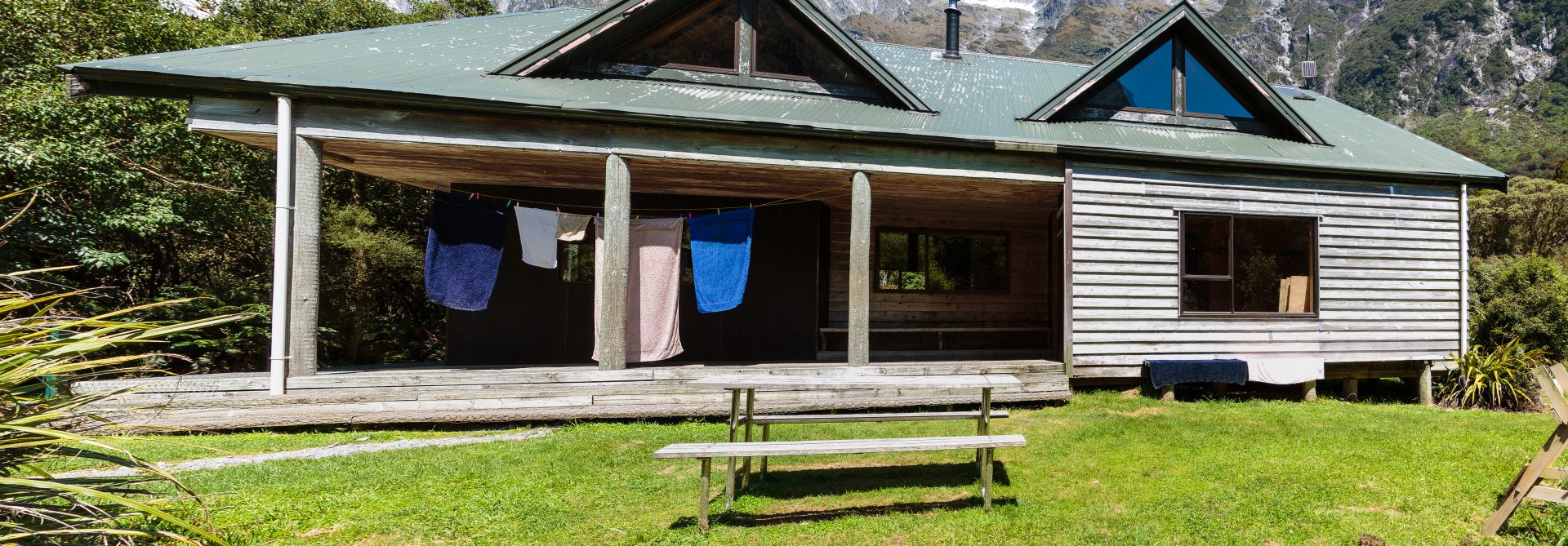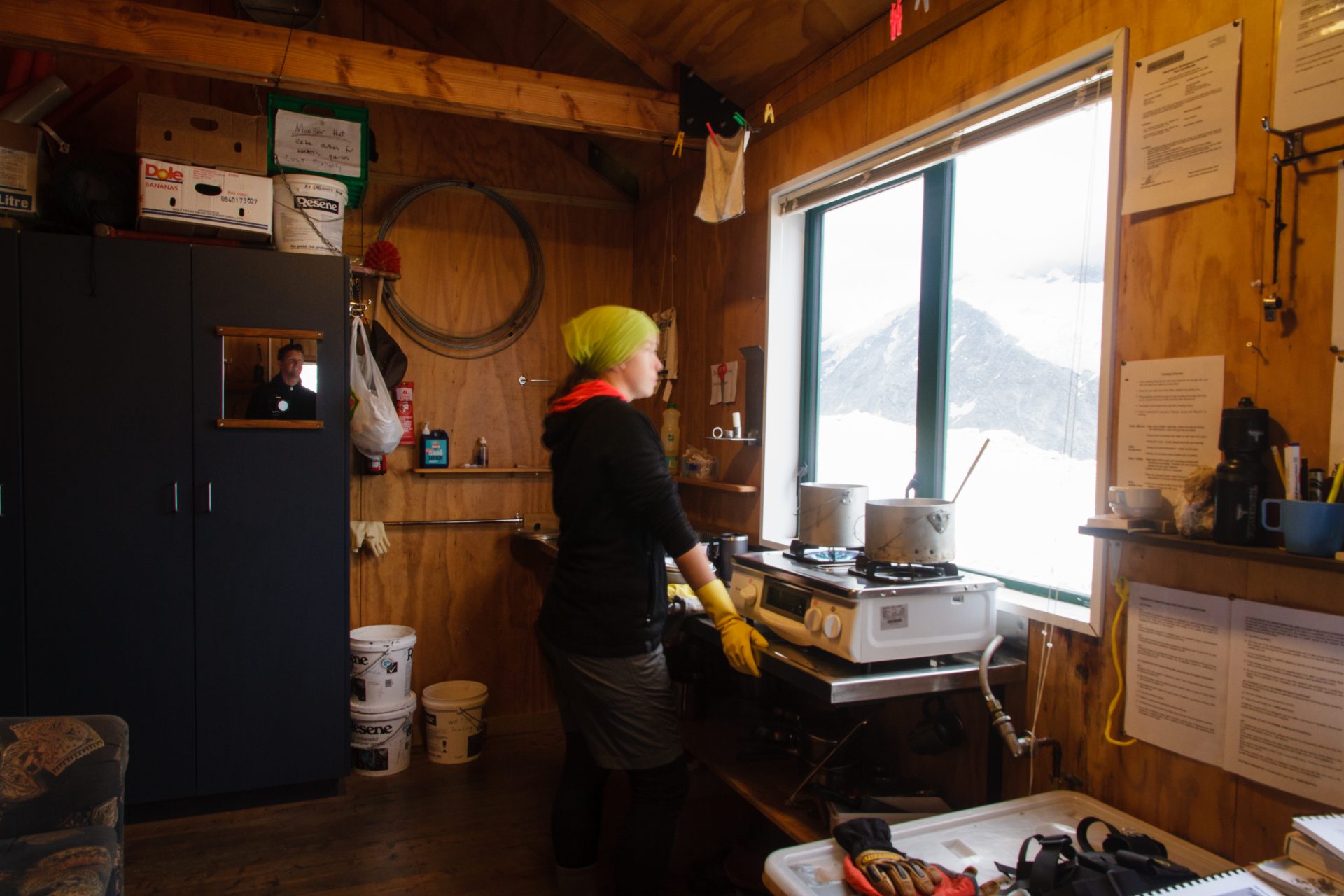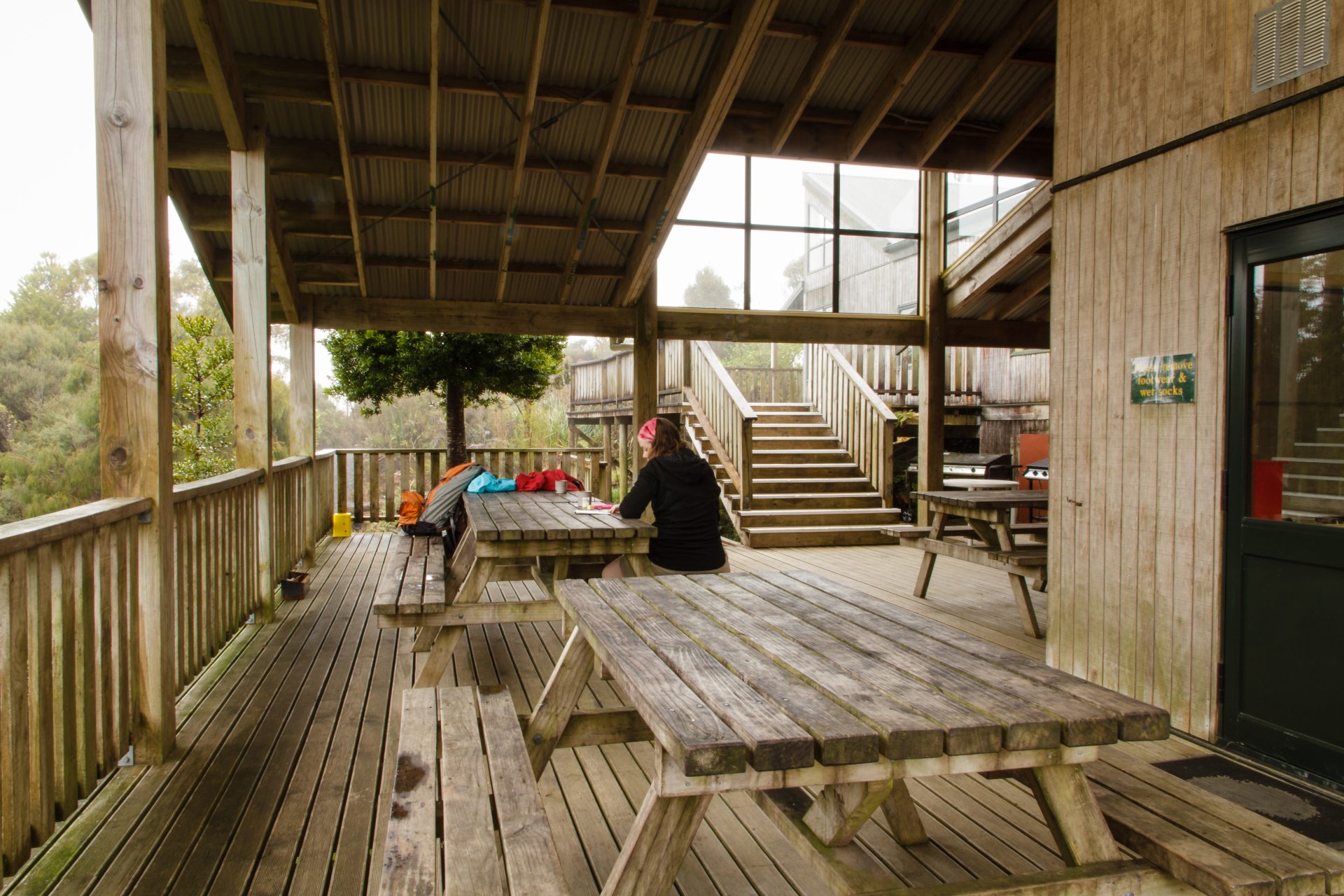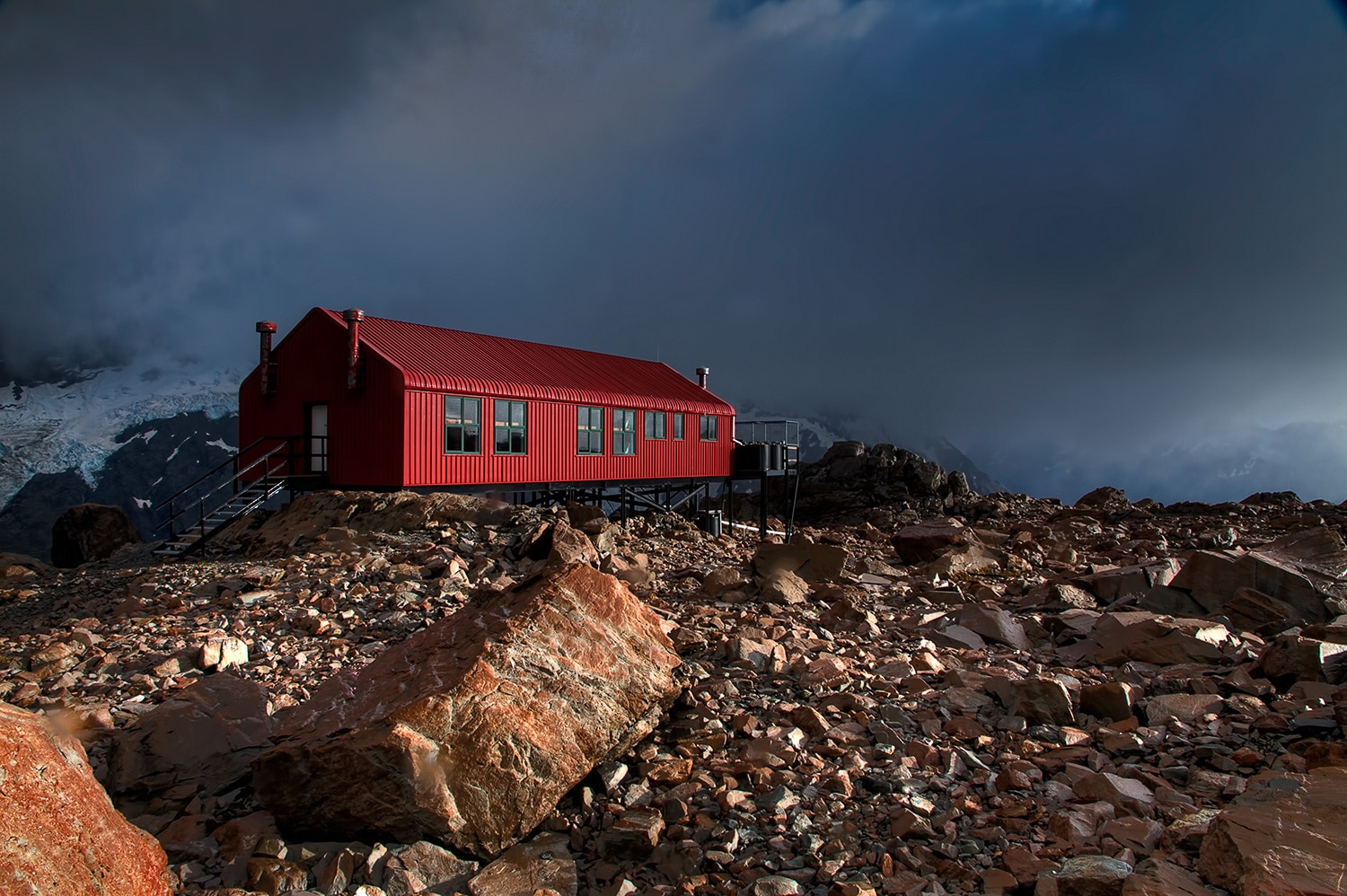Leave no trace
Leave no trace is one of the core tenants of responsible backcountry use. It’s a simple concept – leave the wilderness as you found it for the animals and the next people visiting to enjoy. (Leave No Trace, n.d.)
This concept is an overreaching idea but also provides a good guideline for hut use.
Boots off and keep it clean
Keep the dirt out of the hut.
Yes – you are tired, you are likely wet, and you could be covered in mud. But that does not mean you should just walk straight into the middle of the hut and start stripping off your gaiters and boots in the middle of the floor. Most huts have a deck. Many huts even have an anti-chamber or place for the wet gear. While it’s tempting to get inside and in front of that fire (and warmth) as quick as possible, unless it is an actual emergency that’s involving hypothermia or exposure – take that extra bit of time to keep the water and mud out of the hut. Of course – should you end up traipsing some dirt through the hut – then you also need to remove it again – brooms and brushes are often provided for precisely this purpose.

Preserve water sources – use the dipper, do not dunk your bottle.
For many backcountry explorers – the hut system is known and relied upon source of clean, potable water. Don’t change that by contaminating the water – your drinking bladder and other water vessels may not be as clean as you think. Cross-contamination is a very real thing and something we need to be wary of. Many water tanks will have a dipper – a common use water holder that can be used to separate the tank and your water vessel. Use them!
Also – conserve water. Even if there seems to be ample – there is no need to waste water or take more than you need. It is as much the attitude as it is the physical water levels that are important here. Always treat water as the precious commodity it is, before it becomes scarce.
Sweep, wipe, take it with you.
At the end of the stay, try to make the hut as tidy, if not even tidier than you found it. Sweep the floor, wipe down benches, flip up the bedding – all little things that add up over time. Importantly, pack any rubbish you collect or generate out with you. Here is an important one – the fire is not a rubbish bin! – the amount of cans you find in fires is stunning. Like the person putting it in there somehow thinks a fire is going to smelt an aluminium or steel can away! Don’t be so lazy – pack it in, pack it out!
Use the toilets, if provided.
This one is a personal bugbear. Having volunteered as a hut warden at a couple of DOC huts, nothing is more frustrating as having to explain to all new visitors to a hut, that there are toilets provided, please use them, don’t take a dump behind a nearby tree because the long-drop is a bit smelly, too far, or for any other hair-brained excuse you might come up with. This notion is particularly important in the alpine huts – because – due to the unique environment – waste doesn’t break down like in bush areas – so it’s sadly, becoming more and more common to discover human waste behind rocks and tucked in other places. If we do not use the toilets, then the entire area slowly becomes covered in (sh)it. This is unpleasant and unsanitary – as water might be drawn from underground sources, streams and the like – and no-one really wants to be drinking other people’s faeces. If there isn’t a toilet – check to see if there is already a designated area away from the hut. It is likely away from water intake as well. If creating your latrine – then there are best practices to be followed. (‘Principle 3’, n.d.)

Be the Firestarter, but do not start fires!
Follow the hut rules
Huts will generally have posed rules regarding fires. Somewhat obviously, if there is not a fireplace (open or closed in), then you really should not be building a fire in there! There will be guidance about how to leave the fire, where to find firewood, what firewood to gather, where to dispose of ask and so on. Read them, follow them. Even if they seem a little goofy, there will be a reason they are there. Do not like them? Fine. Don’t use the hut, or follow the rules and then get in contact with the caretakers afterwards to discuss your concerns.
Be aware of cooking on wooden tables
We have likely all done it – but there are also cases where it has been identified as the cause of a hut burning down. You should not leave any fire or ignition source (meaning a gas cooker for example) unattended, but also be very aware of doing so on potentially flammable surfaces. You will generally find a metal-faced cooking area – like the bench and sink.

Reset the fire – but beware of embers
It’s always a good practice to replace used fuel (wood), and it’s a long tradition also to ensure that the next person coming in can quickly start a fire. This again is also a safety consideration – if you have someone coming into the hut that desperately needs some warmth, a fire ready to go with a box of matches next to it, single match sticking out (think frostbitten fingers here) could make a lot of difference. However – you also need to be aware while setting up the next fire – of any remaining embers that might be still alive under the ash. Walking away from a hut, with the fireplace smouldering and starting to ignite again is not a good practice.
Dispose of ash properly
Scoop it out, put it where it is designated to go. This not only ensures the efficiency of the fire; it’s an excellent way to ensure that all the embers are out before resetting it for the next user. Be a good guy. Do your bit.
Human interactions
Yes, unfortunately, there might be other humans present in your temple of solace. Sorry about it, it is the way it is sometimes. Your interaction, particularly if you are a hunter, can leave a lasting impression on other users and the outdoors community overall.
Say hello, make them feel welcome
Even if you have had the place to yourself for a couple of days, and you have developed a bit of an ownership complex, make an effort to make new arrivals welcome. Bonus points – while they are getting established – see if they would like a cuppa – or just get up and put some water on for them. Especially coming out of the cold or wet – it’s a sure-fire way to ‘break the ice’ and ensure you get off on a good start.

Drop the politics
We all have different backgrounds. Do not assume. We share the hut system with non-hunters, with tourists, with people of all backgrounds and ideals. Honour that. This is not the time to fire up a heated debate about gun laws or the like while being isolated in close confines with others who may not share your opinion. Also – it’s not a bad idea to also consider others listening in on your conversations. Finally – in modern times, things like bigotry or casual racism do not belong out in public. Or in private for that matter.
Blood, gore
The front deck is not the place to gut out the animal you just shot. Some huts will have areas for processing animals – some will even have a ‘chiller’ of sorts to hang a carcass in. Ideally, gut out the animals away from the hut – this is both for appearances as well as hygiene and vermin reasons – no need to attract critters to the living areas that do not need to be there. I can hear people already grizzling about ‘real-life’ and ‘shouldn’t be eating meat if they can’t stomach it’ already. You are missing the point. The point is maintaining a good relationship with non-hunters and, should they be interested, then inviting them into the sometimes-messy world that we all understand and know as hunters.
On saying that – frying up a backstrap for dinner? Want to score some instant hunter PR bonus points? Take the opportunity to directly share one of the core tenants of hunting; gathering prime protein for eating. It is an excellent opportunity to engage non-hunters directly. Via their stomachs!
Do not be the person borrowing essential equipment
This is not only a consideration factor but also a basic safety one as well. Any good trip starts with proper planning – and that includes ensuring you have all the equipment you may need. While it might be tempting to save some weight by not taking in certain bits of kit, it is also wise to plan for not even making it to the hut – what happens if you are delayed? What happens if you get there and the place has burnt down? Things like gas cookers, gas, water, are things that should be included in your packing. On the flip side, should you or someone else require something due to that moment of forgetfulness that we all sometimes experience – help a guy out!

Keep your kit contained
Another of my pet peeves. Stow your stuff and keep it tidy. Even if you start out as the only person in the hut, keeping your gear condensed and organised keeps things handy, findable, and organised. Yes – drying clothing out sometimes requires spreading it around the hut – but if others turn up, have the conversation, and better still – make them some space – because they will also need to dry out some kit.
Do not spread yourself out over all the bunks – even if some are available. You may have others coming into the hut while you are out on a day trip – and it is hard to tell how many beds are available if one person has managed to spread the contents of their pack over all three bunk beds.
Tone it down!
Do not take a guitar, or more modern here, a Bluetooth speaker and blare out hard-rock or psytrance the entire time you are in a hut. Use earplugs. Also, be aware that full volume earplugs (get your hearing tested bud) are still loud in the remote setting of a backcountry hut. Some people are there to hear the birds or the crackling of the fire.
Snoring? Take extra earplugs
Snore? That is part of life. But be aware of it, and maybe consider taking some spare earplugs to hand out to others. It is a slightly humorous way of addressing the issue. Also – if you do sound like a chainsaw – consider that when setting up your bunk – some huts have multiple rooms – maybe all the noisy buggers can go sleep in their own!
Are you getting up early? Pack the night before.
While it’s not realistic to expect long sleep-ins in the backcountry huts – we also have to remember that getting up at 4 am to be on top of a ridgeline before sunrise is a decision particular to hunters (and some photographers). Discuss this with other hut users the night before – if everyone is planning on getting up early anyhow – first up and put the kettle on and act as an alarm clock for the rest of the inhabitants.
If an early start is not on the books for everyone, then getting the kit ready and sorted the night prior is an excellent planning exercise, and a little courteous for those rising at a more reasonable time.
You will not be able to be entirely silent, that’s ok – but don’t be banging around in the cupboards and frying up a massive feed while half the hut is still trying to sleep. You might appreciate the same courtesy on the last day.
Fill in the log, leave intentions, talk to fellow users
While this is important for all travellers and a basic safety premise, (Mountain Safety Council New Zealand — Tell Someone Your Plans, n.d.) letting people know your intention both before you even leave, and updating those plans along the way ensures that, should you need it, the search and rescue teams already have a head start in knowing where you were going. If plans change (and they often do due to weather or other unforeseen reasons), a hut log is an excellent way of people being able to see where you have ended up.
Must huts will have a logbook of some kind, and not only is this a nice tradition and a good way of spending some time reading through who else has been through the hut (and there are sometimes good yarns to be read), but it is a record of the travels as well.
Besides, talk to your fellow occupants – especially for hunters – this is an opportunity to see who is heading where, what has been seen, what has been taken – it could give you clues on both where you might consider heading out to, as well as the knowledge of where animals are, aren’t and even more importantly – where other people might also be wandering around the hillsides.

Firearms
Hunters have guns. It is particular to them, typically. Like I say during the firearms licencing courses, we must remember that for the public, their exposure to firearms is likely limited to movies and the media, neither of which is an accurate representation of actual firearms users. The other exposure to firearm users, though, is going to be you. Make sure it is a positive experience for them.
Presentation
Unload those guns, take the bolts out and be aware of your demeanour as you enter a hut area. A group of guys covered in blood and guts, swearing, waving around firearms can be a bit of a rough introduction to someone who has never been exposed to it before. We need to remember we are used to seeing guns in guys hands. That is not common to everyone.
You do not necessarily need to show ‘bolt open; rifle cleared’ to people at the hut. If you are not a gun person – that is a bizarre thing for someone to do to you – they will have no idea why or what you are showing them anyhow. Much better – do not make much of an issue of it at all. Clear the rifles, put them aside, secure them, forget about them. Do not slap them down on the middle of the table and throw a handful of ammo next to it.
Remember
Huts are there for EVERYONE to enjoy. Not just trampers, not only hunters, not just people who live in New Zealand. Everyone. We are all ambassadors for firearms owners – like it or not – and your actions both directly related to hunting and firearms and just generally as a backcountry hut user do reflect on all of us. Make sure each interaction with others is positive.
[/membership]

